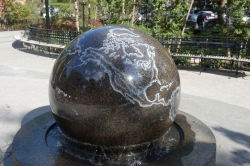James Madison Plaza
James Madison Plaza
James Madison Plaza takes its name from the combination of the two street names that bound it, St. James Place and Madison Street. St. James Place is named for nearby St. James Roman Catholic Church, located on Oliver Street. Madison Street was originally known as Bancker Street, after a son-in-law of the noted philanthropist Henry Rutgers (1745-1830). In 1826, after the Banckers asked that their family name be withdrawn from the street, the City of New York renamed the thoroughfare Madison Street in honor of the fourth President of the United States, James Madison (1751-1836).
James Madison was born to a prominent family in Orange County, Virginia in 1751. He attended the College of New Jersey, now known as Princeton University, graduated in 1772, and returned to Virginia. Madison first became involved in local politics in 1774 when he joined the Orange County Committee of Safety. Two years later, he was elected to the Virginia Assembly. His intelligence and skill earned him a place in the 1787 Constitutional Convention, where he helped to draft much of our current Federal Constitution. Madison also played a large role in securing the ratification of the Constitution after the Convention. Along with John Jay and Alexander Hamilton, he wrote several essays, now known as the Federalist Papers, which argued for the adoption of the Constitution. Historians have long since recognized Madison’s involvement in the creation of our national government, naming him “the Father of the Constitution.”
Following the ratification of the Constitution in 1789, Madison continued his involvement in national politics. He served as Virginia’s Congressman from 1789 to 1797, and helped draft the Bill of Rights. From 1801 to 1809, Madison served as Secretary of State under President Thomas Jefferson (1743-1826). Together with Jefferson, he formed the Democratic-Republican Party. The party formed largely in opposition to Alexander Hamilton’s national plan for economic development. For Madison, Jefferson, and other Democratic-Republicans, this plan endangered the nation’s future.
Elected President of the United States in 1808, Madison fought to preserve the new nation’s autonomy. When Great Britain and France began seizing American trade ships and impressing sailors into their respective navies in the 1800s, Madison instituted a trade embargo against both nations. Great Britain nevertheless increased its harassment. On June 1, 1812, Madison secured a congressional declaration of war, signaling the start of the War of 1812. While most historians consider the war a draw, few dispute that the new United States of America emerged from the conflict with a newfound patriotism and pride.
Following his presidency, Madison retired to his home in Virginia in 1817. He continued his involvement in public affairs advising President James Monroe (1758-1831), and serving as a delegate to the 1829 Virginia Constitutional Convention. In 1836, after years of public service, Madison died in his home.
This land was deeded to the City of New York in 1964 as part of the Chatham Green Towers project, and came under Parks jurisdiction that same year. The triangle remained undeveloped until the late 1970s when Parks planted trees and installed planters around the triangle’s edges. In 1993, the City Council renamed the traffic triangle surrounding the plaza after Mother Frances Xavier Cabrini (1850-1917 ), a Roman Catholic missionary and the first American citizen to be canonized.
Check out your park's Vital Signs
Clean & Safe
Green & Resilient
Empowered & Engaged Users
Share your feedback or learn more about how this park is part of a
Vital Park System

